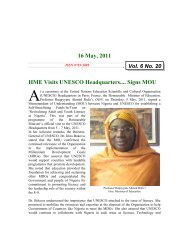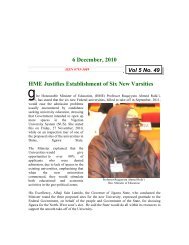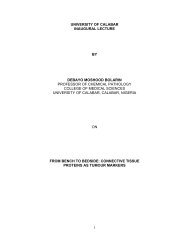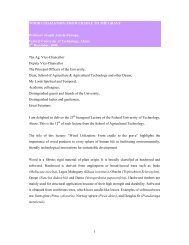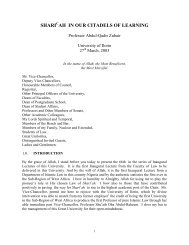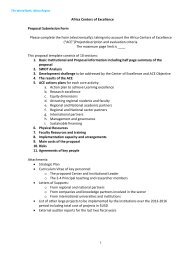THE VARIED ROLES OF SNAILS - National Universities Commission
THE VARIED ROLES OF SNAILS - National Universities Commission
THE VARIED ROLES OF SNAILS - National Universities Commission
You also want an ePaper? Increase the reach of your titles
YUMPU automatically turns print PDFs into web optimized ePapers that Google loves.
(a) Small intestine<br />
– Fasciopsis buski<br />
– Heterophyes heterophyes<br />
– Metagonimus yokogawai<br />
– Watsonius watsoni<br />
(b) Large intestine<br />
– Gastrodiscoides hominis<br />
(iii) Respiratory tract<br />
– Paragonimus spp.<br />
In the snails the miracidia develop into sporocysts followed<br />
by two generations of rediae and later (3 months after) give<br />
rise to very short tailed cecariae (micro- cercous Xiphidio-<br />
cercariae). These emerge from the snail and swim in water<br />
and can survive for 24-48 hours. If they find freshwater<br />
crabs they enter.<br />
The crab species include Potamon, Sesarma, Eiocheir and<br />
Sudanonautes or freshwater crayfish – Astacus. They<br />
penetrate and encyst in the gills or muscles as<br />
metacercariae. The Freshwater crustaceans can probably<br />
become infected by ingesting unencysted cercariae in the<br />
water or even inside infested snail.<br />
The disease is insidious beginning with a non-specific<br />
cough that becomes chronic and is productive of blood<br />
tinged sputum known as endemic haemoptysis. Patients<br />
also experience pleural pain and dyspnoea. Depending<br />
upon secondary bacterial infection there may be<br />
pneumothorax and pleural adhesion. Lesions in the brain<br />
can lead to seizures.<br />
(e) Clonorchiasis<br />
84




